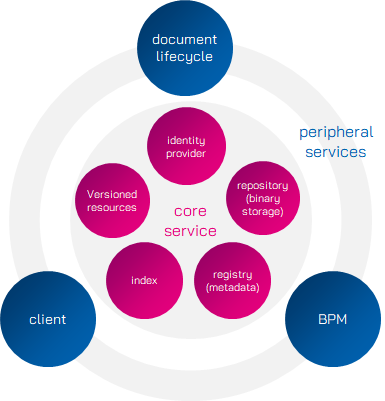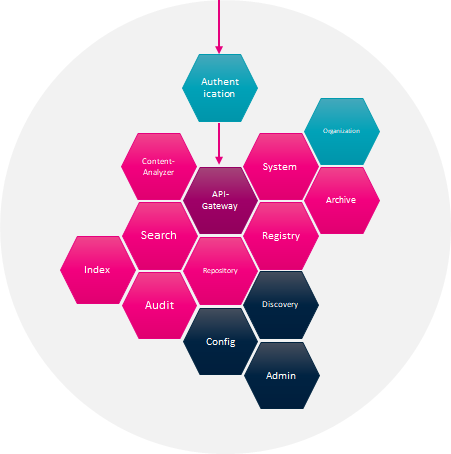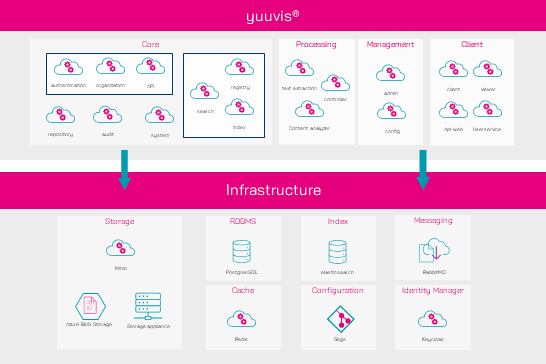 yuuvis® Momentum
yuuvis® Momentum
We have recently changed the URL structure of our developer documentation. Redirects for the most important pages are set up. However, we cannot guarantee that all your bookmarks will still find their intended destination. Please also refer to the search in the top bar or the navigation on the left-hand side to find what you are looking for.
We apologize for any inconvenience.
What is yuuvis® Momentum?
Think of yuuvis® Momentum as a tool for accelerated development of tailored content and information management solutions.
Solutions build using yuuvis® Momentum are highly scalable, run either cloud native or on premises and exhibit outstanding performance. yuuvis® Momentum offers you to tap into existing user management and is readily integrated into an existing system environment via its ReST-API. Functionality is easily expanded using concepts like Webhooks, AMQP Hooks and Interceptors. It offers a complete Audit Trail, performant Search features in an SQL-like manner and Rights Management. It supports asynchronous document processing via Tagging, evolving documents via the Schema Flow and handling of Compound Documents. And all that with support for multi-tenancy with administration on global system as well as on tenant level.
Key Features
- API first
- Excellent scalability - high performance on big amounts of data
- Docker/Kubernetes
- No commercial databases etc. required
- multi-tenancy
- Docker/Kubernetes
- hybrid: runs in cloud or on premises
- Simplified operation and administration
- Nearly no downtime
Search this Documentation
Popular Topics
- additional_service
- ai
- amqp_hook
- api
- app
- archive
- audit
- authentication
- bpm
- catalog
- client
- commander
- compound
- concept
- configuration
- contentanalyzer
- core
- docu
- document_lifecycle
- folder
- frontend
- gui
- inference
- installation
- interceptor
- internal_endpoint
- kairos
- localization
- logging
- object_type
- permissions
- prediction
- profile
- rendition
- repository
- retention
- role
- sap
- schema
- search
- system_hook
- tag
- tenant_management
- tutorial
- userservice
- validation
- webhook
- worked_on
What can yuuvis® Momentum be used for?
yuuvis® Momentum is a state-of-the-art tool for building content and information management solutions, supporting deployment scenarios that range from on-premises, private or public cloud to hybrid, using the same cloud-native technology stack everywhere.
If you are concerned about your archive solution not scaling to your amount of documents, if you are not sure whether to keep your data safe on your own hardware or might to move to the cloud later, if you need a platform offering a performant backend to develop your web applications against, yuuvis® Momentum might be the tool of choice for you.
Check out a few use cases here.
What does yuuvis® Momentum look like?
We adopted a layered, microservice-based product architecture, centering on a yuuvis® core, which is the heart of the product. The services of the core are required for the proper operation of a yuuvis® Momentum instance. On top of yuuvis® core, peripheral extensions my be used, but they are not mandatory. This architectural feature enables you to tailor the system according to your needs.
Every software product structurally exemplifies a certain approach to provide solutions to given problems. We describe some of the layered architecture of yuuvis® Momentum to facilitate using its abilities in the intended manner to maximum effect.
yuuvis® Momentum is designed API-first, able to cope with up to 109 objects within one instance. It allows pinpoint scalability and high availability due to its microservice architecture, running either on-premises or in any public cloud supporting kubernetes. It saves on costs by being independent of most commercial software requirements. It incorporates customer multi-tenancy, allowing multiple tenants to use one solution, with complete data separation and tenant administration. Usage of the client offers multi-language support.
The Onion Approach
The digital transformation demands highly customized solutions to serve the needs and expectations of its user and to fully leverage its advantages. These solutions may stress the underlying application from very different angles - think of the different workloads a solution for email archiving poses compared to one facilitating workflows, or to one where analysis and classification and processing of incoming documents are the focus. What they all have in common these times is the need to reliably handle ever-growing amount of documents in an audit-proof manner, guaranteeing performant access via a capable query language over vast amounts of data. All access has to be controllable via an integrated rights management. And deep integration into existing system landscapes should be supported by flexible customization options.
The layered architecture of yuuvis® Momentum consists of a core, which is optimized to deliver the above qualities over a wide range data quantities, and allows for peripheral services to extend its capabilities as needed. This approach allows to maintain peak performance for a wide field of possible tailored solutions.
The yuuvis® Momentum Core
The core itself consists of a collection of microservices.
These are to be connected to standard implementations of its needed resources - an OAuth2 capable identity provider, some binary storage like S3 or NetApp, a relational database like postgres or cockroach as registry, Elasticsearch as powerful Index, and git for storing resources like configurations in a versioned manner.
For more details, visit Core Services.
It is important to notice that the yuuvis® core allows for functional extension (server-side) of its operations by introducing custom microservices as interceptors or by event handling through system hooks: webhooks or AMQP hooks.
Building a Client
yuuvis® Momentum client as reference implementation is the first and major example of an application build for yuuvis® Momentum - Additional Services and Custom Clients. More than a mere showcase, it comes with own services, delivering reusable functionality for client applications, as well as two libraries, facilitating the rapid development of custom client applications in Angular.


